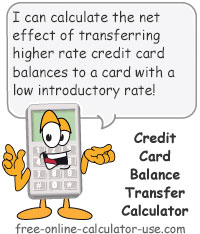IMPORTANT: Numeric entry fields must not contain dollar signs, percent signs, commas, spaces, etc. (only digits 0-9 and decimal points are allowed).
Click the Terms tab above for a more detailed description of each entry.
Step #1:
Complete the Balance Transfer Offer section of the calculator, which includes the introductory rate, length of the introductory term, the post-introductory rate, the annual fee, the transfer fee percentage, and the transfer fee cap.
Step #2:
For each card balance you want to transfer to the new card, enter the card name, balance, interest rate, and annual fee (if any). Tap the "+" ("Add", or "Add Card") button to add the card to the list.
Step #3:
After all cards are entered tap the "Calculate Balance Transfer" button. This will populate the "Introductory" and "Post Introductory" comparison charts, plus display a summary and a bar chart showing the difference between transferring the balances and not transferring the balances.


Follow me on any of the social media sites below and be among the first to get a sneak peek at the newest and coolest calculators that are being added or updated each month.